Denis Helic
Large Language Models as Narrative-Driven Recommenders
Oct 17, 2024Abstract:Narrative-driven recommenders aim to provide personalized suggestions for user requests expressed in free-form text such as "I want to watch a thriller with a mind-bending story, like Shutter Island." Although large language models (LLMs) have been shown to excel in processing general natural language queries, their effectiveness for handling such recommendation requests remains relatively unexplored. To close this gap, we compare the performance of 38 open- and closed-source LLMs of various sizes, such as LLama 3.2 and GPT-4o, in a movie recommendation setting. For this, we utilize a gold-standard, crowdworker-annotated dataset of posts from reddit's movie suggestion community and employ various prompting strategies, including zero-shot, identity, and few-shot prompting. Our findings demonstrate the ability of LLMs to generate contextually relevant movie recommendations, significantly outperforming other state-of-the-art approaches, such as doc2vec. While we find that closed-source and large-parameterized models generally perform best, medium-sized open-source models remain competitive, being only slightly outperformed by their more computationally expensive counterparts. Furthermore, we observe no significant differences across prompting strategies for most models, underscoring the effectiveness of simple approaches such as zero-shot prompting for narrative-driven recommendations. Overall, this work offers valuable insights for recommender system researchers as well as practitioners aiming to integrate LLMs into real-world recommendation tools.
Recommendation Fairness in Social Networks Over Time
Feb 05, 2024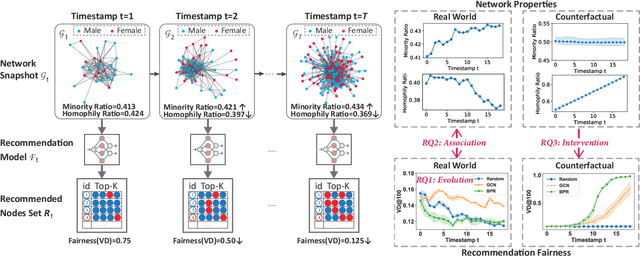

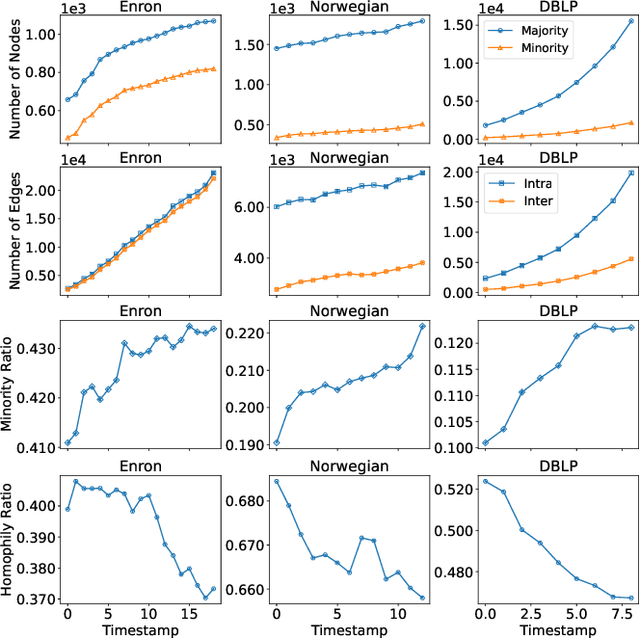
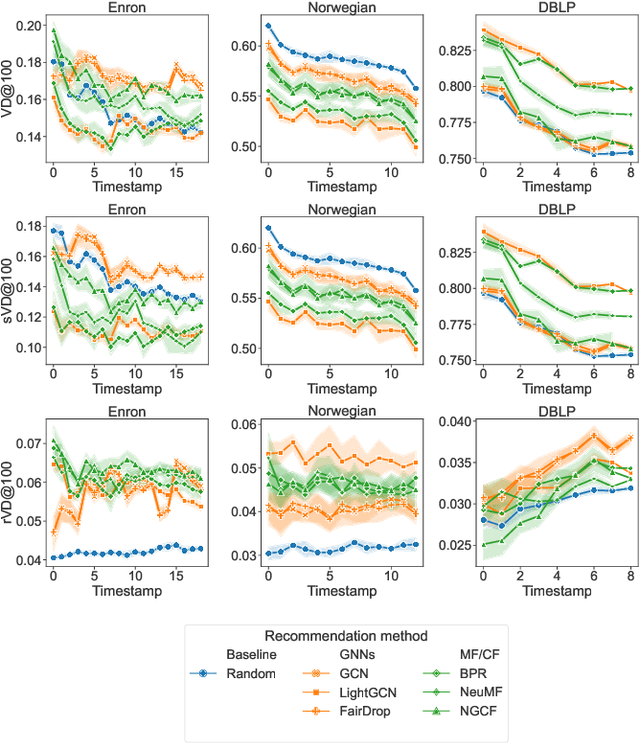
Abstract:In social recommender systems, it is crucial that the recommendation models provide equitable visibility for different demographic groups, such as gender or race. Most existing research has addressed this problem by only studying individual static snapshots of networks that typically change over time. To address this gap, we study the evolution of recommendation fairness over time and its relation to dynamic network properties. We examine three real-world dynamic networks by evaluating the fairness of six recommendation algorithms and analyzing the association between fairness and network properties over time. We further study how interventions on network properties influence fairness by examining counterfactual scenarios with alternative evolution outcomes and differing network properties. Our results on empirical datasets suggest that recommendation fairness improves over time, regardless of the recommendation method. We also find that two network properties, minority ratio, and homophily ratio, exhibit stable correlations with fairness over time. Our counterfactual study further suggests that an extreme homophily ratio potentially contributes to unfair recommendations even with a balanced minority ratio. Our work provides insights into the evolution of fairness within dynamic networks in social science. We believe that our findings will help system operators and policymakers to better comprehend the implications of temporal changes and interventions targeting fairness in social networks.
Adversarial Inter-Group Link Injection Degrades the Fairness of Graph Neural Networks
Sep 13, 2022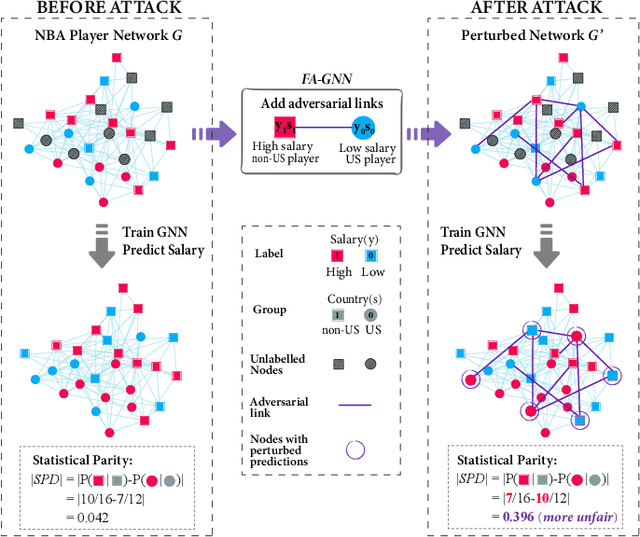
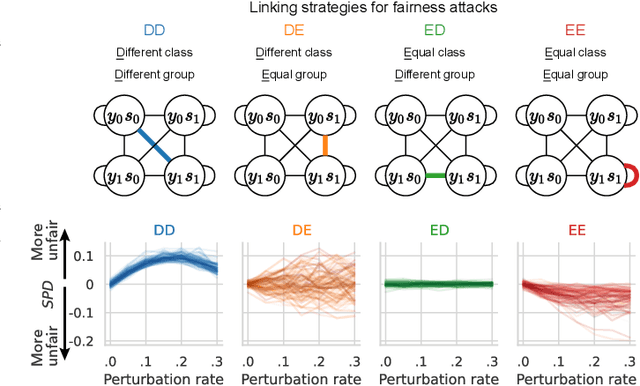
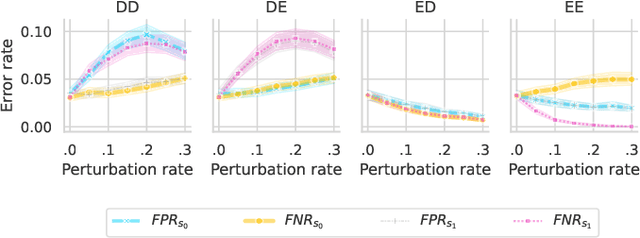
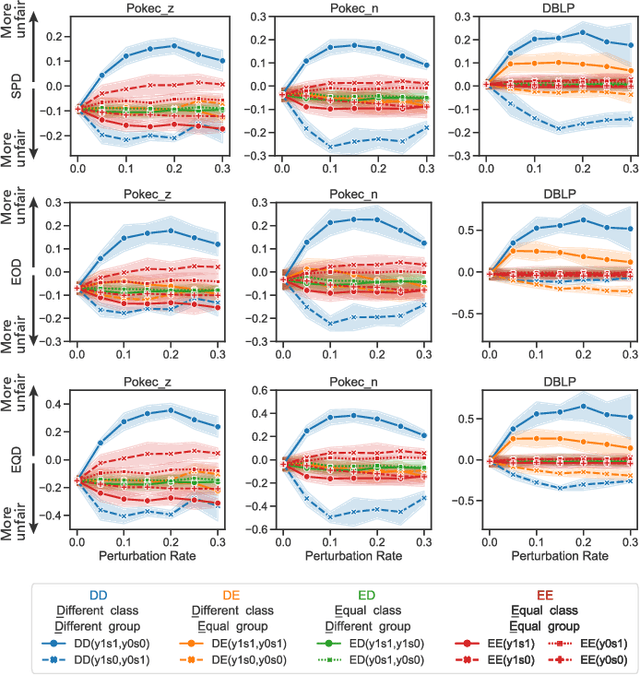
Abstract:We present evidence for the existence and effectiveness of adversarial attacks on graph neural networks (GNNs) that aim to degrade fairness. These attacks can disadvantage a particular subgroup of nodes in GNN-based node classification, where nodes of the underlying network have sensitive attributes, such as race or gender. We conduct qualitative and experimental analyses explaining how adversarial link injection impairs the fairness of GNN predictions. For example, an attacker can compromise the fairness of GNN-based node classification by injecting adversarial links between nodes belonging to opposite subgroups and opposite class labels. Our experiments on empirical datasets demonstrate that adversarial fairness attacks can significantly degrade the fairness of GNN predictions (attacks are effective) with a low perturbation rate (attacks are efficient) and without a significant drop in accuracy (attacks are deceptive). This work demonstrates the vulnerability of GNN models to adversarial fairness attacks. We hope our findings raise awareness about this issue in our community and lay a foundation for the future development of GNN models that are more robust to such attacks.
Structack: Structure-based Adversarial Attacks on Graph Neural Networks
Jul 28, 2021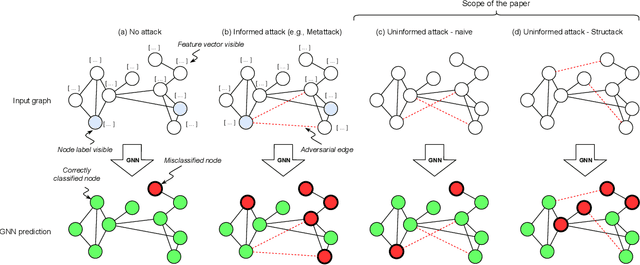
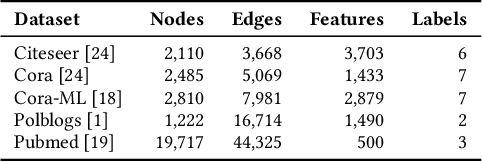
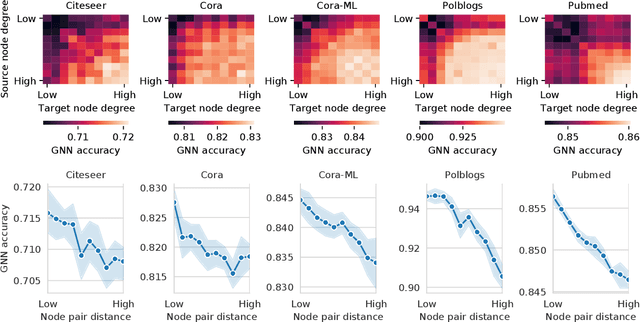
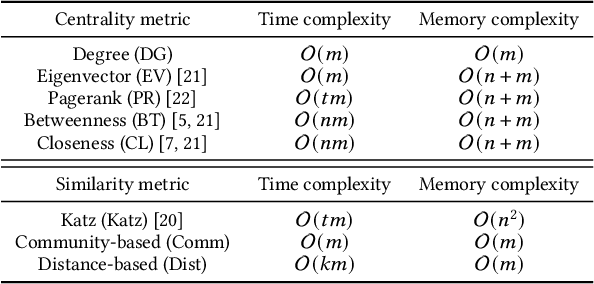
Abstract:Recent work has shown that graph neural networks (GNNs) are vulnerable to adversarial attacks on graph data. Common attack approaches are typically informed, i.e. they have access to information about node attributes such as labels and feature vectors. In this work, we study adversarial attacks that are uninformed, where an attacker only has access to the graph structure, but no information about node attributes. Here the attacker aims to exploit structural knowledge and assumptions, which GNN models make about graph data. In particular, literature has shown that structural node centrality and similarity have a strong influence on learning with GNNs. Therefore, we study the impact of centrality and similarity on adversarial attacks on GNNs. We demonstrate that attackers can exploit this information to decrease the performance of GNNs by focusing on injecting links between nodes of low similarity and, surprisingly, low centrality. We show that structure-based uninformed attacks can approach the performance of informed attacks, while being computationally more efficient. With our paper, we present a new attack strategy on GNNs that we refer to as Structack. Structack can successfully manipulate the performance of GNNs with very limited information while operating under tight computational constraints. Our work contributes towards building more robust machine learning approaches on graphs.
RFID-based Article-to-Fixture Predictions in Real-World Fashion Stores
May 21, 2021



Abstract:In recent years, Radio Frequency Identification (RFID) technology has been applied to improve numerous processes, such as inventory management in retail stores. However, automatic localization of RFID-tagged goods in stores is still a challenging problem. To address this issue, we equip fixtures (e.g., shelves) with reference tags and use data we collect during RFID-based stocktakes to map articles to fixtures. Knowing the location of goods enables the implementation of several practical applications, such as automated Money Mapping (i.e., a heat map of sales across fixtures). Specifically, we conduct controlled lab experiments and a case-study in two fashion retail stores to evaluate our article-to-fixture prediction approaches. The approaches are based on calculating distances between read event time series using DTW, and clustering of read events using DBSCAN. We find that, read events collected during RFID-based stocktakes can be used to assign articles to fixtures with an accuracy of more than 90%. Additionally, we conduct a pilot to investigate the challenges related to the integration of such a localization system in the day-to-day business of retail stores. Hence, in this paper we present an exploratory venture into novel and practical RFID-based applications in fashion retails stores, beyond the scope of stock management.
Surfacing Estimation Uncertainty in the Decay Parameters of Hawkes Processes with Exponential Kernels
Apr 02, 2021
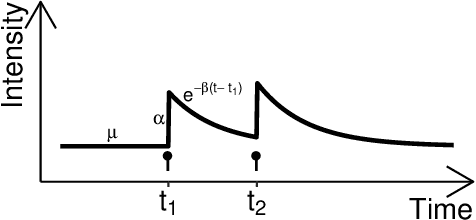

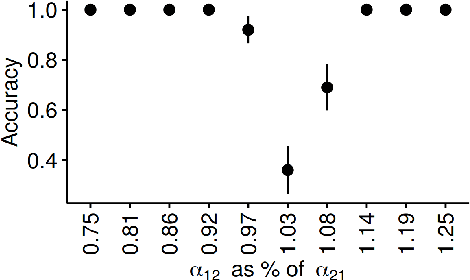
Abstract:As a tool for capturing irregular temporal dependencies (rather than resorting to binning temporal observations to construct time series), Hawkes processes with exponential decay have seen widespread adoption across many application domains, such as predicting the occurrence time of the next earthquake or stock market spike. However, practical applications of Hawkes processes face a noteworthy challenge: There is substantial and often unquantified variance in decay parameter estimations, especially in the case of a small number of observations or when the dynamics behind the observed data suddenly change. We empirically study the cause of these practical challenges and we develop an approach to surface and thereby mitigate them. In particular, our inspections of the Hawkes process likelihood function uncover the properties of the uncertainty when fitting the decay parameter. We thus propose to explicitly capture this uncertainty within a Bayesian framework. With a series of experiments with synthetic and real-world data from domains such as "classical" earthquake modeling or the manifestation of collective emotions on Twitter, we demonstrate that our proposed approach helps to quantify uncertainty and thereby to understand and fit Hawkes processes in practice.
Synwalk -- Community Detection via Random Walk Modelling
Jan 21, 2021



Abstract:Complex systems, abstractly represented as networks, are ubiquitous in everyday life. Analyzing and understanding these systems requires, among others, tools for community detection. As no single best community detection algorithm can exist, robustness across a wide variety of problem settings is desirable. In this work, we present Synwalk, a random walk-based community detection method. Synwalk builds upon a solid theoretical basis and detects communities by synthesizing the random walk induced by the given network from a class of candidate random walks. We thoroughly validate the effectiveness of our approach on synthetic and empirical networks, respectively, and compare Synwalk's performance with the performance of Infomap and Walktrap. Our results indicate that Synwalk performs robustly on networks with varying mixing parameters and degree distributions. We outperform Infomap on networks with high mixing parameter, and Infomap and Walktrap on networks with many small communities and low average degree. Our work has a potential to inspire further development of community detection via synthesis of random walks and we provide concrete ideas for future research.
On the Impact of Communities on Semi-supervised Classification Using Graph Neural Networks
Oct 30, 2020
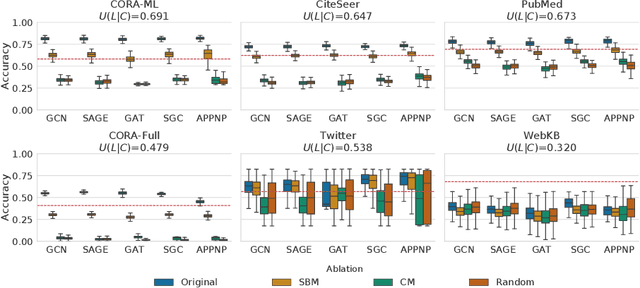

Abstract:Graph Neural Networks (GNNs) are effective in many applications. Still, there is a limited understanding of the effect of common graph structures on the learning process of GNNs. In this work, we systematically study the impact of community structure on the performance of GNNs in semi-supervised node classification on graphs. Following an ablation study on six datasets, we measure the performance of GNNs on the original graphs, and the change in performance in the presence and the absence of community structure. Our results suggest that communities typically have a major impact on the learning process and classification performance. For example, in cases where the majority of nodes from one community share a single classification label, breaking up community structure results in a significant performance drop. On the other hand, for cases where labels show low correlation with communities, we find that the graph structure is rather irrelevant to the learning process, and a feature-only baseline becomes hard to beat. With our work, we provide deeper insights in the abilities and limitations of GNNs, including a set of general guidelines for model selection based on the graph structure.
Empirical Comparison of Graph Embeddings for Trust-Based Collaborative Filtering
Mar 30, 2020

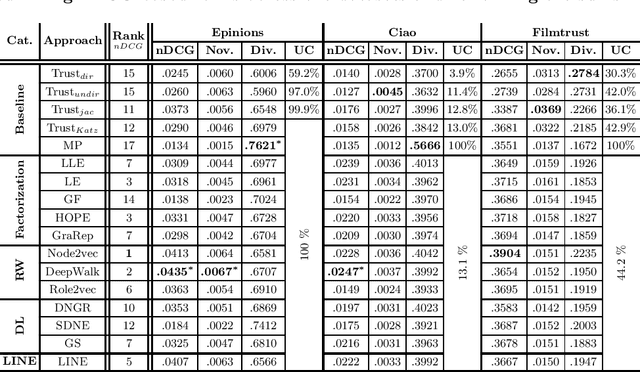
Abstract:In this work, we study the utility of graph embeddings to generate latent user representations for trust-based collaborative filtering. In a cold-start setting, on three publicly available datasets, we evaluate approaches from four method families: (i) factorization-based, (ii) random walk-based, (iii) deep learning-based, and (iv) the Large-scale Information Network Embedding (LINE) approach. We find that across the four families, random-walk-based approaches consistently achieve the best accuracy. Besides, they result in highly novel and diverse recommendations. Furthermore, our results show that the use of graph embeddings in trust-based collaborative filtering significantly improves user coverage.
How Users Explore Ontologies on the Web: A Study of NCBO's BioPortal Usage Logs
Oct 31, 2016



Abstract:Ontologies in the biomedical domain are numerous, highly specialized and very expensive to develop. Thus, a crucial prerequisite for ontology adoption and reuse is effective support for exploring and finding existing ontologies. Towards that goal, the National Center for Biomedical Ontology (NCBO) has developed BioPortal---an online repository designed to support users in exploring and finding more than 500 existing biomedical ontologies. In 2016, BioPortal represents one of the largest portals for exploration of semantic biomedical vocabularies and terminologies, which is used by many researchers and practitioners. While usage of this portal is high, we know very little about how exactly users search and explore ontologies and what kind of usage patterns or user groups exist in the first place. Deeper insights into user behavior on such portals can provide valuable information to devise strategies for a better support of users in exploring and finding existing ontologies, and thereby enable better ontology reuse. To that end, we study and group users according to their browsing behavior on BioPortal using data mining techniques. Additionally, we use the obtained groups to characterize and compare exploration strategies across ontologies. In particular, we were able to identify seven distinct browsing-behavior types, which all make use of different functionality provided by BioPortal. For example, Search Explorers make extensive use of the search functionality while Ontology Tree Explorers mainly rely on the class hierarchy to explore ontologies. Further, we show that specific characteristics of ontologies influence the way users explore and interact with the website. Our results may guide the development of more user-oriented systems for ontology exploration on the Web.
 Add to Chrome
Add to Chrome Add to Firefox
Add to Firefox Add to Edge
Add to Edge